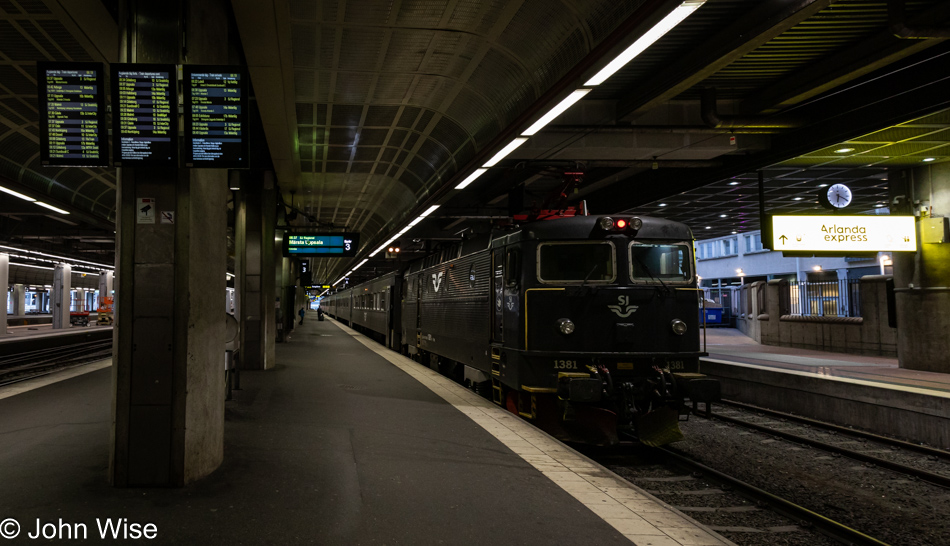
Staying near the train station allowed us to shake ourselves out of bed at 5:45. Since we’d be too early for the breakfast buffet at the hotel anyway, this was our version of sleeping in. By 6:15, we were at the central train station for our brief 40-minute ride to Uppsala to the north.

Things to notice in this photo: Caroline is holding a cup of coffee, which will accompany the Kardemummabullar and the Kanelbullar in the paper bag at the top of her purse. She is wearing a wool undershirt beneath her huipil, and her sweater is draped over her arm. This morning’s temperature was in the low 40s (5.5 Celsius), with the promise of localized flooding over the course of the day. We are entering the 1st class car because even for a short ride, it’s nice to know that professional bonbon eaters seem to specialize in riding at the front of the train.

It doesn’t look like rain is on the horizon to us either, but it was cold. Speaking of cold, I’ve typically provided distances, weights, and temperatures in Imperial and Metric measurements for years, and today we are visiting the city where Anders Celsius was born and hope to be able to pay homage to him, should we find a monument to his memory. Uppsala also is the home of Carl Linnaeus, the father of modern taxonomy. More about him later.
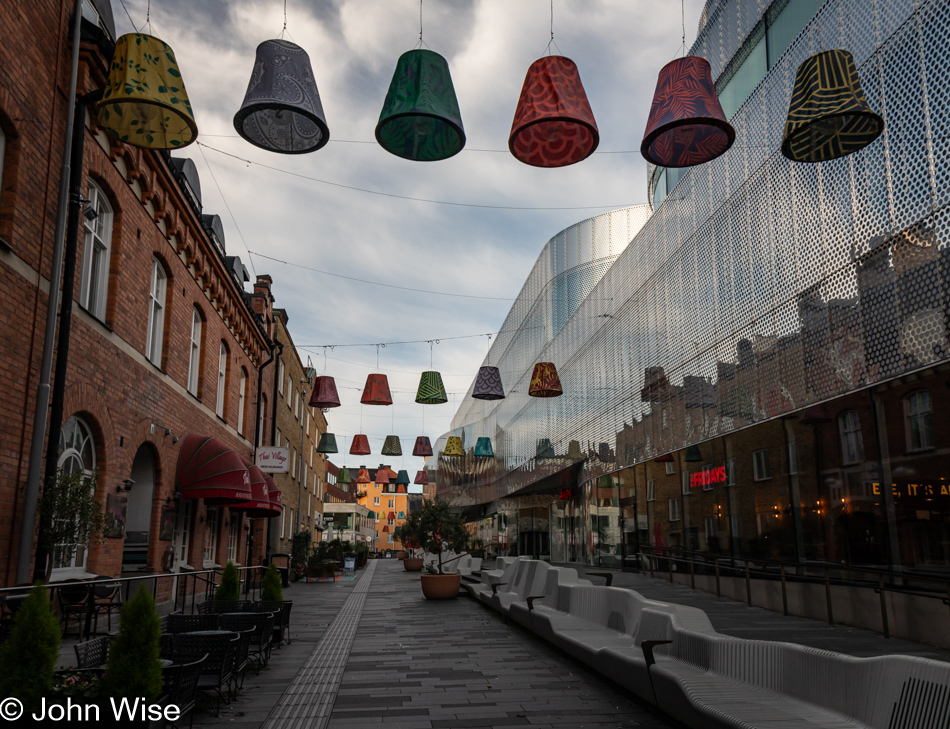
Most people haven’t yet started to stir on this early Sunday morning, and here we are at 7:15 already in Uppsala. The original reason behind this visit was that I’d read there would be a good number of runestones here; little did I know that we’d have already seen nearly half a dozen of these Viking-age monuments. And while there’s still plenty to see in Stockholm, even if we’d have canceled this side trip, we still couldn’t have seen a fraction of what’s to be appreciated in Sweden’s capital city. Now we need to venture out and make our way to Gamla Uppsala, and if you’ve not realized it yet, Gamla means old.

Rarely, though, is anything as simple as A = B with us, though, in some way, it seems that way if you were in our heads. Sure, we’re essentially on our way to Gamla Uppsala, but there are things between us and our destination, so the equation might be better written as A(a1+a2 / a3 x a4) + B(b1 x b2 + b3²) = P(A∪B). Or, in simpler terms, we’ll do stuff after getting to a place, we’ll deviate if our attention is drawn into a distraction, and then maybe we’ll reach our destination and do other stuff that was known or unknown to us prior to our arrival, but in the end, everything will be great.

This might have just one more building that caught my eye, but I tried searching for a similar image and stumbled upon Lady Dandelion’s now-neglected blog, where she took a nostalgic walk across the Uppsala University campus after graduating and identified this particular house as the Department of Law.
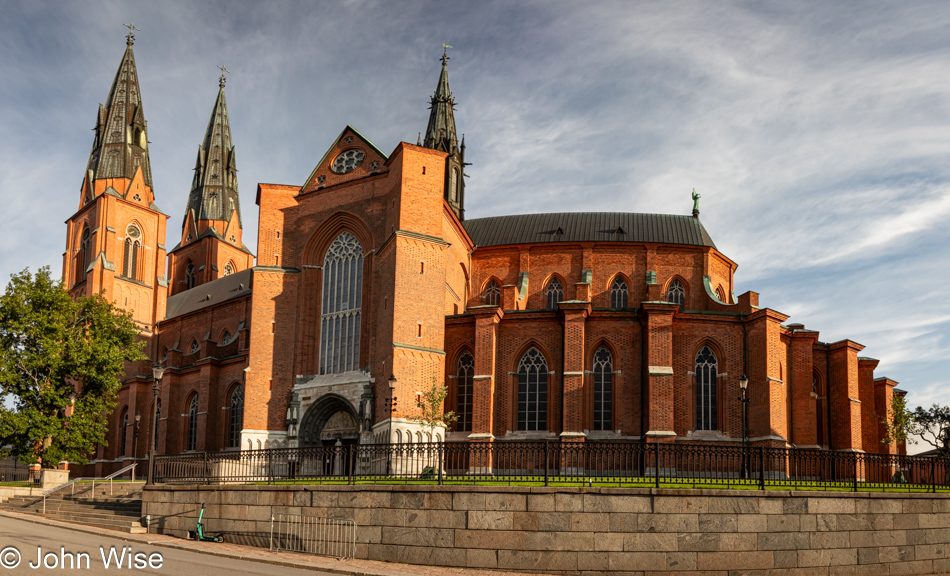
This is Uppsala Cathedral, and it’s not open yet. You might notice some curvature on the right side of the photo for which I should apologize because it is distorting the view, but this is an assemblage of 16 different shots I took as the cathedral was too big for my lens. As a panorama, however, it turned out acceptable from my perspective. Since we’re too early, we’ll look around for something else that’s holding our interest and come back here in a bit.
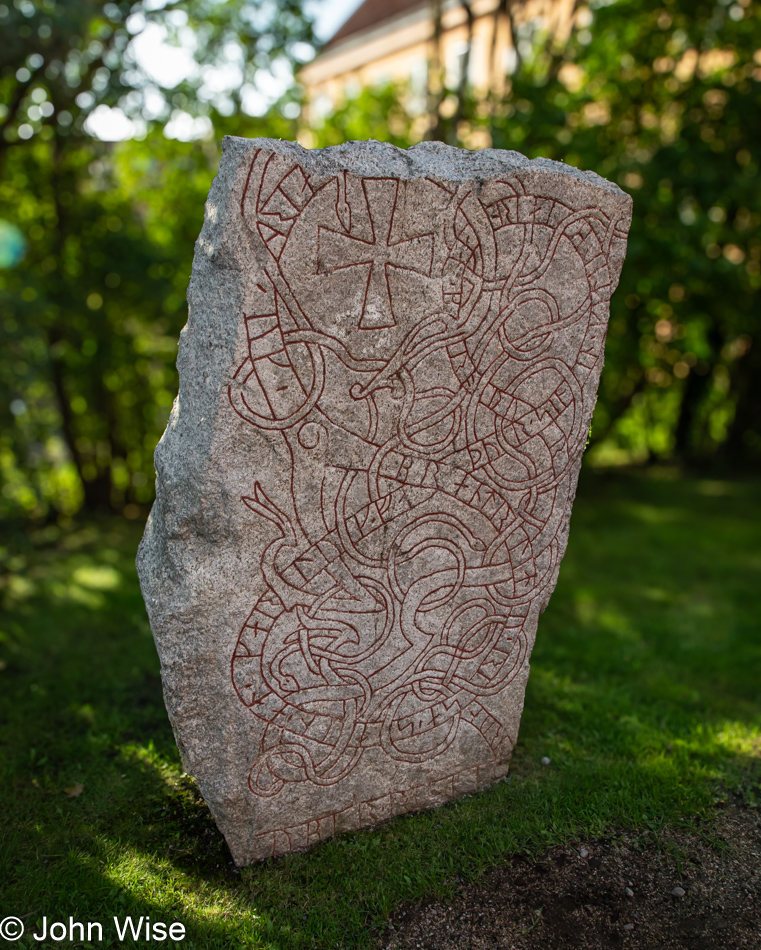
Prior to leaving the United States, minus the runestone embedded in the building in Stockholm, we assumed it would be here in Uppsala that we would first see these 1000-year-old inscribed stones in the wild, so to say. This one reads, “Björn and Brand had this stone carved for their father Karlung, and Kättilbjörn for his brother. Öpir carved the runes.”
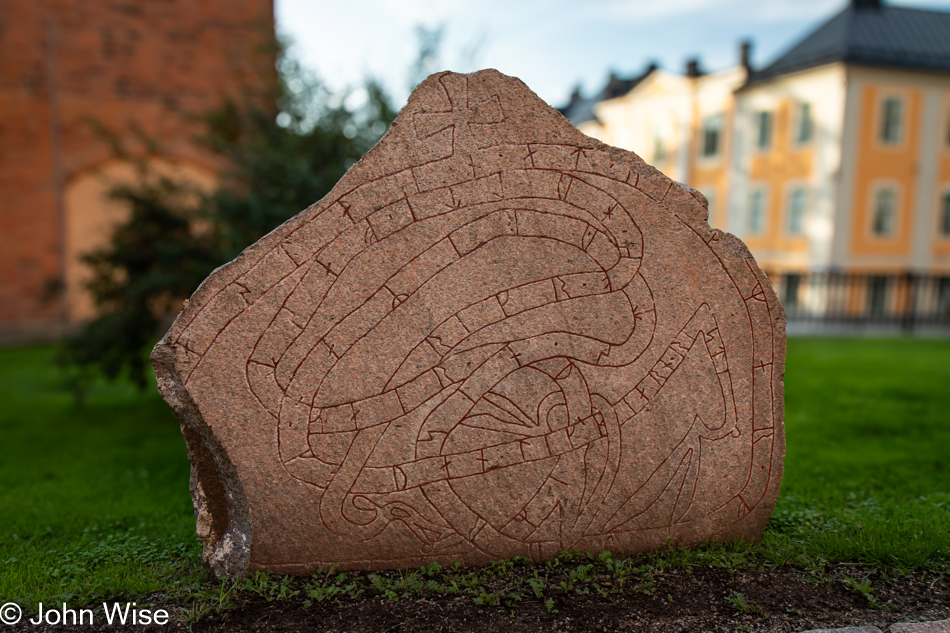
There are more runestones here, but we need to get over to the cathedral as they open so we can get moving to the north of town. As for the translation of this inscription, it reads, “Ríkr/Rekkr/Hringr and Holti and Fastgeirr, they had … the stone in memory of Vígmarr, their father, a good captain. Líkbjôrn carved.”
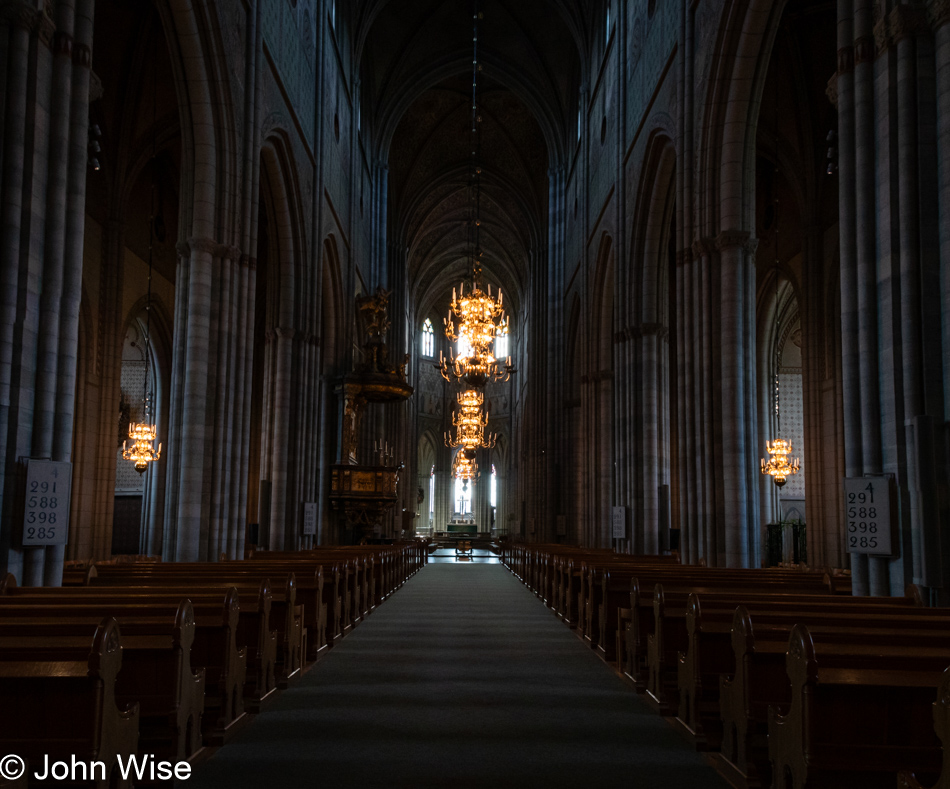
The doors to the cathedral have opened, and we are quick to enter as we don’t know when services might begin, which is likely considering it’s Sunday. This is the tallest church in the Nordic countries, standing at 118.7 meters (389 feet). Construction of this church began in 1272 over the site of a stone church that once stood here and was the location where King Eric IX died, helping cement his legacy and earning him the title of Patron Saint of Sweden, but I’m getting ahead of myself as I didn’t learn of this until well after our visit.

Two days ago, on the day of our arrival in Stockholm, I wrote about the orientation of cathedrals and how Storkyrkan, like other churches that adhere to this design principle, places the sanctuary to the east and the entry doors to the west, allowing the early morning sun to illuminate the church and visitors to experience the views exemplified by this series of photos.
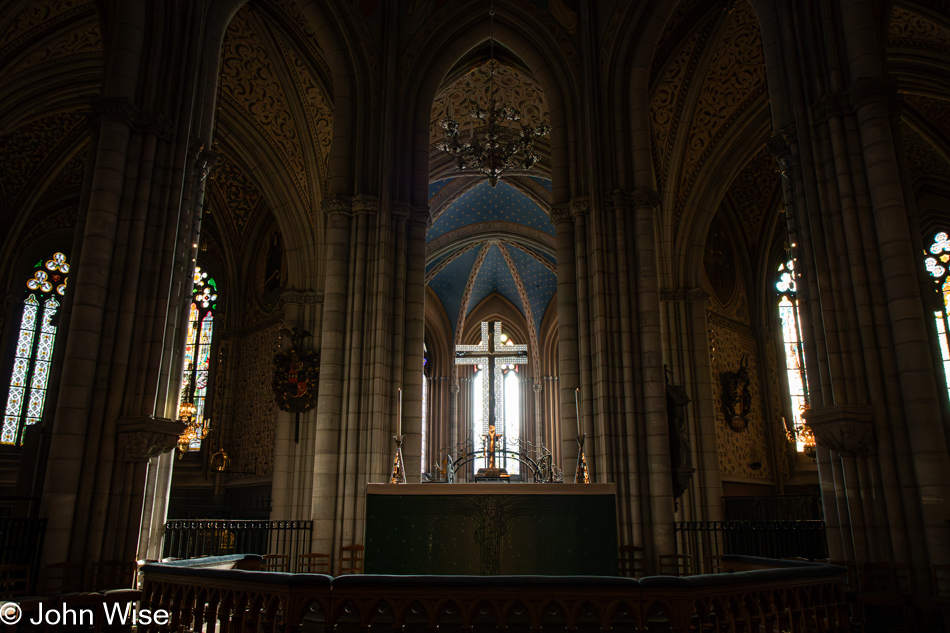
All three of the first images here were taken as I got closer to the altar, and while one of them should have sufficed, I couldn’t help but use them all as I believe each portrays a beauty unique from the other.
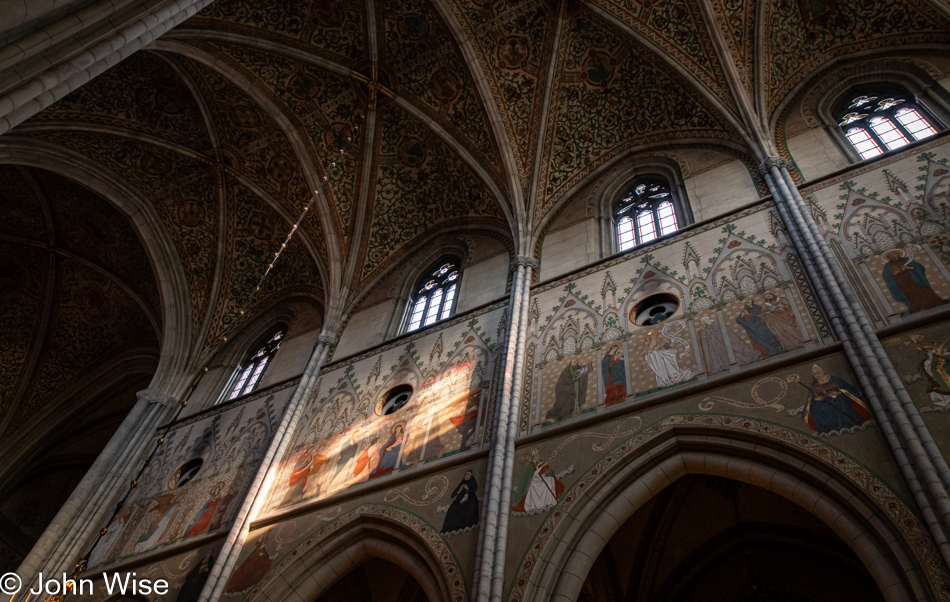
A devastating fire raged through the cathedral in 1702, requiring new stained glass and frescoes. If any of the original survived, I don’t have that information.
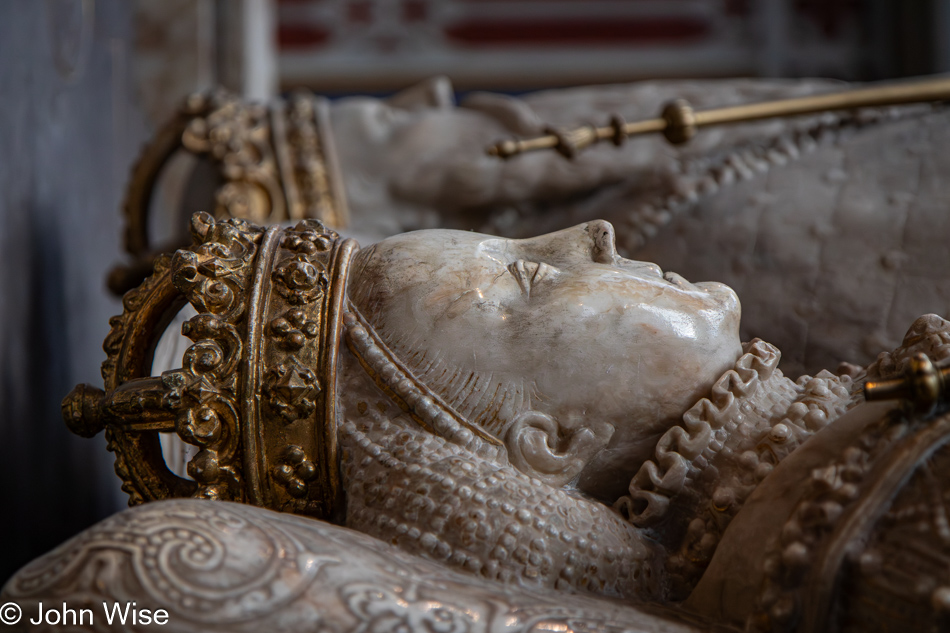
While there are three queens buried in this tomb, only the first two queens of King Gustav I are featured in the memorial marble carving along with the king himself, as the third queen was still alive at the time her husband died.
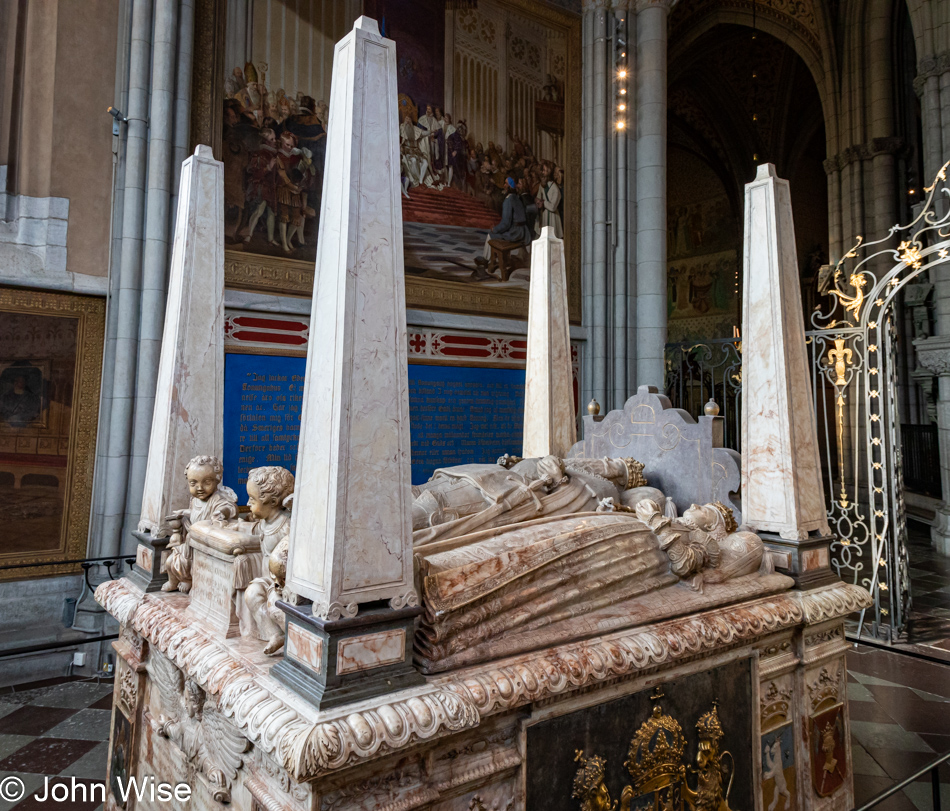
The grave monument to King Gustav I is in the cathedral’s front chapel, which was once known as the Chapel of the Virgin Mary but was renamed the Vasa Chapel. It was right here at the Uppsala Cathedral that Gustav Vasa was crowned king as were most monarchs from the time of the Middle Ages until 1719. King Gustav I ruled for 37 years, longer than any other Swedish monarch besides the current monarch, King Carl XVI Gustaf.

What exactly was this that I photographed near King Gustav I’s tomb? I’m tempted to write someone at the cathedral to determine what this was from, but I’ve already spent countless hours researching details about this vacation, and in the scheme of things, exactly who is ever going to look to this website to learn about a gold-faced angel that is part of a larger plate? If I were to talk to lady dandelion, who I referenced earlier, she’d likely tell me I might be surprised.
A stroke of luck bumped into me the following day when I returned to this post. I was reading further details about the cathedral where it spoke of the Patron Saint of Sweden, King Eric IX, prior to mentioning that this was the resting place of King Gustav I. I thought this was odd because if Gustav Vasa was the first true king of Sweden, why did King Eric receive top billing? So I followed an embedded link to the story of Eric and came across a photo of his relic casket that had me thinking about this photo right here. One of the images in the articles had just enough detail that I could confirm that I had captured but a tiny piece of the reliquary.
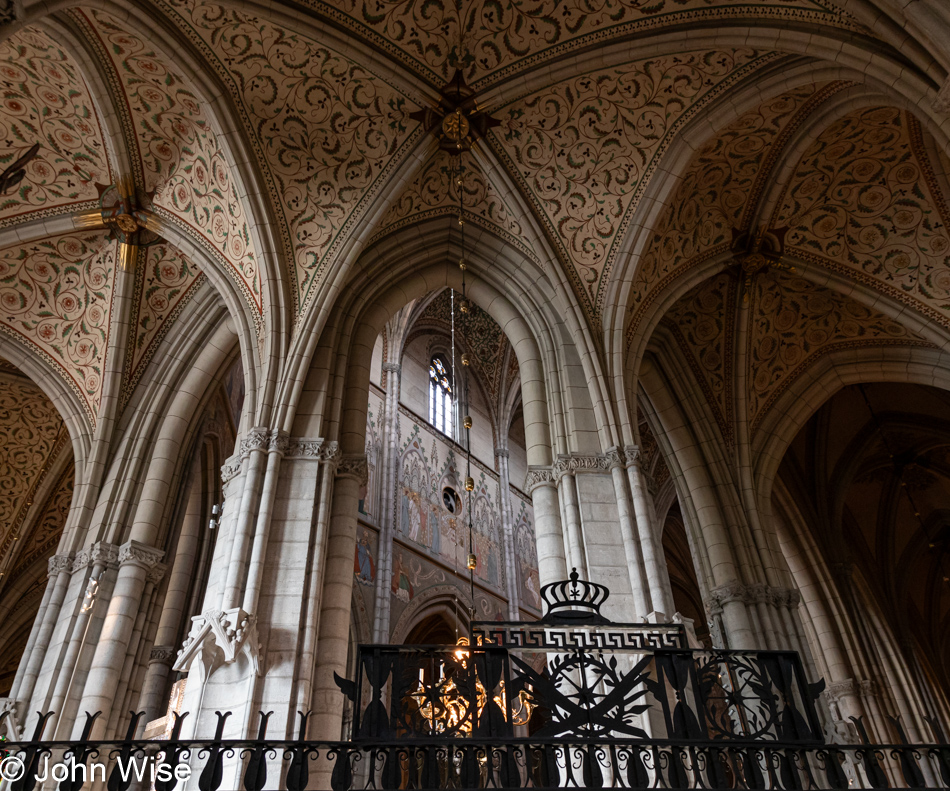
Okay, this is just too many photos shared from this cathedral, but what is a person to do when this type of architecture speaks to their heart? When Notre Dame was devastated by fire, Paris and France had no choice but to restore it as it is one of the major tourism draws that round out a number of architectural wonders that bring visitors by the millions to the City of Light, but what of these cathedrals only a rare few ever visit? Maybe Uppsala Cathedral would be rebuilt as a matter of national pride due to its storied history to Swedes, but will another cathedral of such majesty ever be undertaken again?

Being the son of King Gustav I obviously had its perks, as witnessed by the monumental tomb of King John III. This has me thinking that I might like such an extravagant eternal resting place. It makes for a good argument that we should be teaching our children tools such as ZBrush or 3DCoat sculpting software so they can learn how to craft such ornate virtual tombs for their parents and themselves. Then again, wishing for society at large to begin adapting to complexity is like asking the man buried under all that marble to return to life.
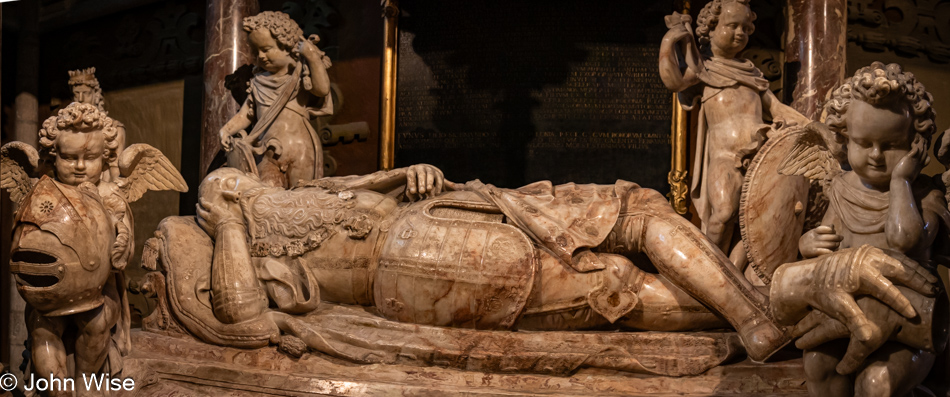
The repose of King John III must be one of the most chill and casual of all tomb carvings ever made, as I’ve never seen a person of such royal lineage looking like he’s taking a nap after a hard day on the throne. The angels holding his armor and shield while waiting for the king to wake and return to battle is a nice touch.
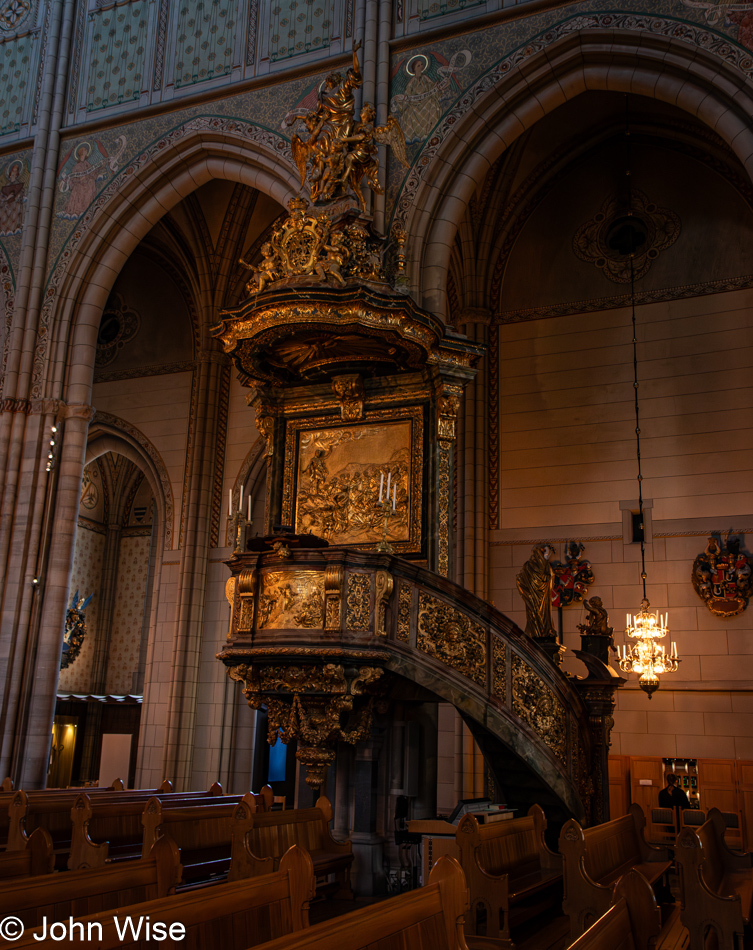
Often more opulent than an altarpiece, the pulpit, also called an ambon at times, is set to the left side of the church and played a more important role in the church prior to the advent of electronic systems capable of amplifying the clergy presenting scripture.
Note to John and Caroline: next time in Europe, be sure to visit the Basilica of Saint-Pierre-aux-Nonnains in Metz, France, and the Cathedral of St. Peter in Trier, Germany, which are both from the early 4th century and the Aachen Cathedral in Germany that features one of the oldest pulpits still in existence. All three locations are about 2 to 4 hours away by train from Frankfurt.

I couldn’t fault anyone who might arrive at the conclusion that I’m on a pilgrimage to visit an inordinate number of churches, which is quickly approaching 20 such buildings, but I’d say that I’m simply gravitating towards the center of where European life congregated to find unity for the better part of 1,000 years.

Caroline the Navigator had us going every which way as we tried to find a public transportation spot where we could catch a bus or tram to Gamla Uppsala. Well, at least that’s what she was deciphering on her phone. We ended up walking in what felt like circles, with the stop proving elusive, so looked for a trail that would allow us to walk.
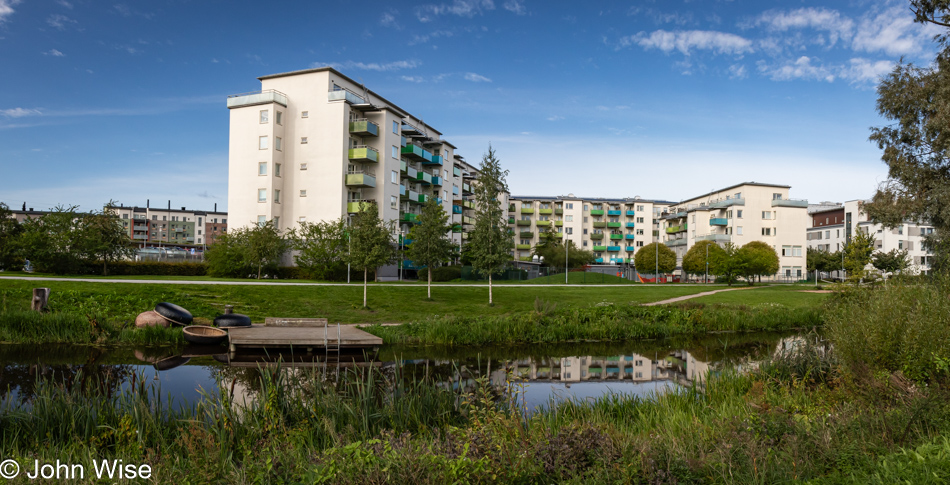
We are now walking out of Uppsala proper on our way to Gamla Uppsala, and with only an hour’s walk, we’ll certainly beat any rain that might show up, which doesn’t look like it’s really in the forecast anymore.
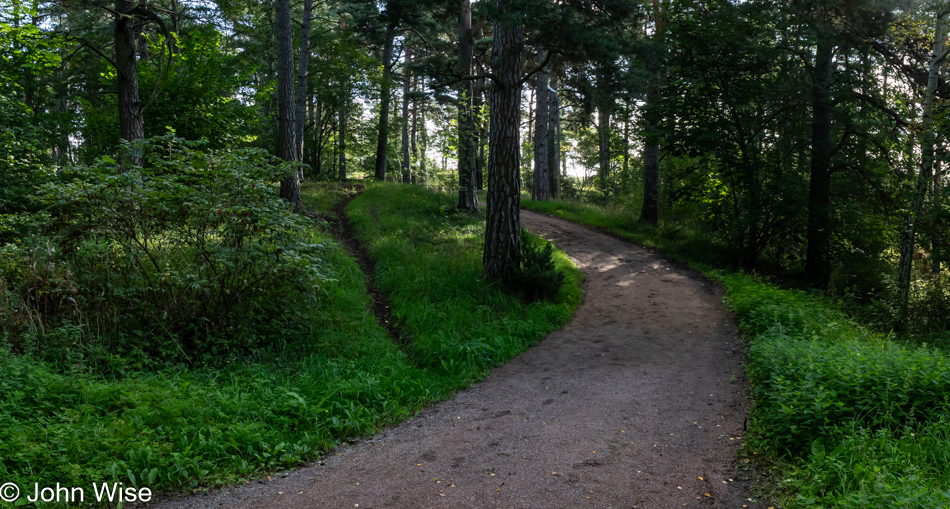
We are in love with our walk across the Swedish countryside and once again can’t get over our good fortune of being in the right place at the right time. We walk hand in hand, tell one another how much we are in love, and stop to look around incredulous that these are the sights in rural Sweden. This is not the first time we have exclaimed such things; we do this dozens of times a day as an hour doesn’t go by before we are reminded by another exquisite moment that we are living a charmed life.
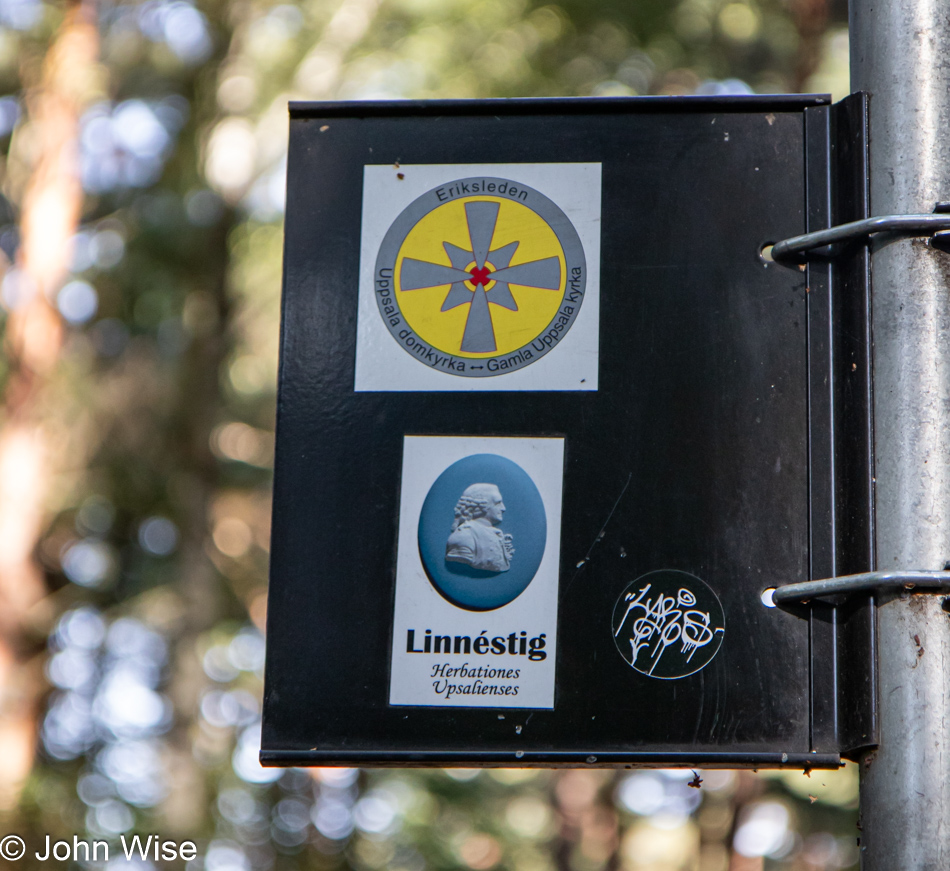
Signs along the way denote that we are traveling the Eriksleden pilgrimage and Linnaeus trails. Regarding the Linnaeus part of the trail, these were the paths that Carl Linnaeus used as an educator to take his students into the places where he studied nature while creating his ideas about taxonomy. The particular locations that warrant greater study are called herbations.
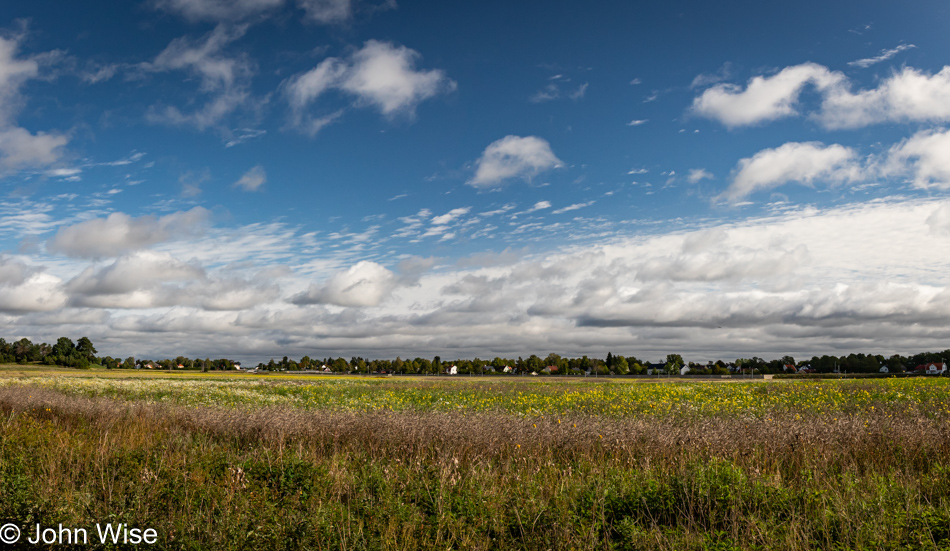
The wool shirts and Caroline’s sweater are now a burden as the weather couldn’t be better for a long walk into history.
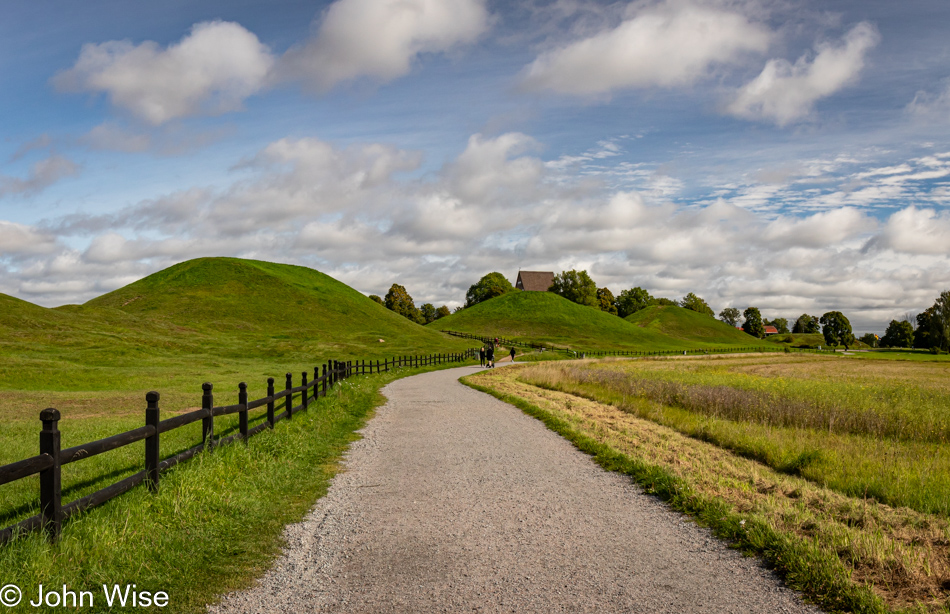
These burial mounds are the primary reason we’ve walked out here. In reading about the area, it’s been inhabited for about 2,000 years, ever since it rose above sea level. I had to read that last part twice but I read it right. You see, most of Sweden has been experiencing what is known as isostatic rebound or post-glacial rebound, where land that was once situated considerably lower due to the weight of ice-age sheets of ice have been rising and is still doing so. While Gamla Uppsala lies 25 meters or 82 feet above sea level today, Stockholm, where we are staying, sits only about 28 meters (92 ft) above sea level, and to its east, more than 24,000 islands and islets are still emerging from the sea.
While these three Royal Mounds are the most obvious burial sites, there were between 2,000 and 3,000 at one point, but the majority were plowed under to make way for farmland. The mounds are considered Sweden’s oldest national symbols, dating to between the 5th and 6th centuries. In Norse mythology, this is the burial site of Thor, Odin, and Freyr.
Another 4th mound was supposed to be the site of where the annual Disting occurred, an annual market and fair that coincided with the observation of Dísablót. This observation was held in honor of the female spirits or deities but was also the time when the “Ting of all Swedes” took place. A “Ting” was essentially a council or assembly meeting where community leaders gathered to discuss trade, legal, and military functions and dates back to early Roman times. As a side note, I also read that the German word for Tuesday, Dienstag is related to the “Ding.”

When I was planning our trip, I thought this was the Old Church of Gamla Uppsala and that it was a stave church. In my cursory glancing at stuff about places, I missed that this was the old bell tower of the church and could not be visited. What is this attraction to ancient structures, art, words, and sounds that draw us humans in to find secrets and mysteries from our ancestors’ pasts? It is as if we are wishing for something to speak out from our distant history, where echoes of the past are waiting just for us.

While popular mythology (tourism bait?) appears to enjoy the idea that about 1000 years ago, there may have been a pagan temple here, modern archeology says that’s not true and instead points to evidence of two prior stone churches that once stood on this site. What is undeniable is that Gamla Uppsala once played a large role in Swedish politics, religion, and economy, which you could easily imagine if it were true that gods were interred here. Up until the 12th century, when the Uppsala Cathedral was built, the coronation of kings took place right here in Gamla Uppsala at a temple, according to 11th-century chronicler Adam of Bremen.
Let’s return then to this idea of a pagan temple standing here: there are conflicting stories that state that postholes and log lines have been discovered that support the accounts from Adam of Bremen and Snorri Sturluson. I’ve read that this temple was burned down by King Inge the Elder in the 1080s, which has me wondering if the denial of a temple here in Gamla Uppsala is to support ideas of Christianity while denying a Norse/Viking/Pagan past.
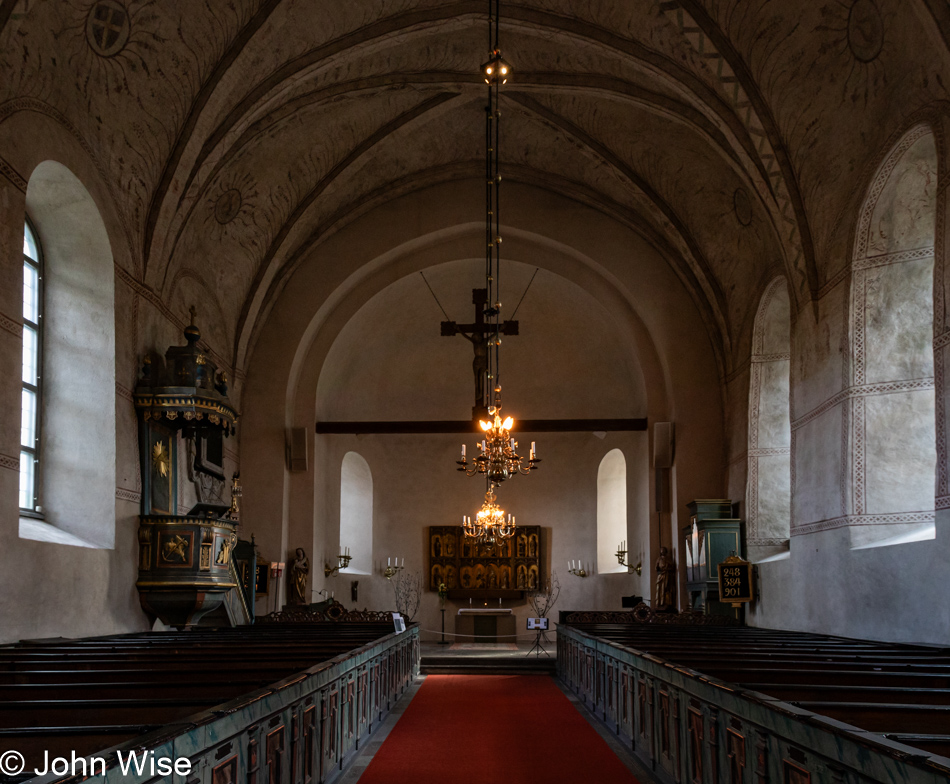
Inside the church, a red carpet runs the length of the nave, and beneath it is the grave of Anders Celsius. It’s not covered to deny visitors from seeing it, but in order to protect it from being worn away by our footsteps. King Eric IX was once buried here, too, until he was moved south to the cathedral in Uppsala.
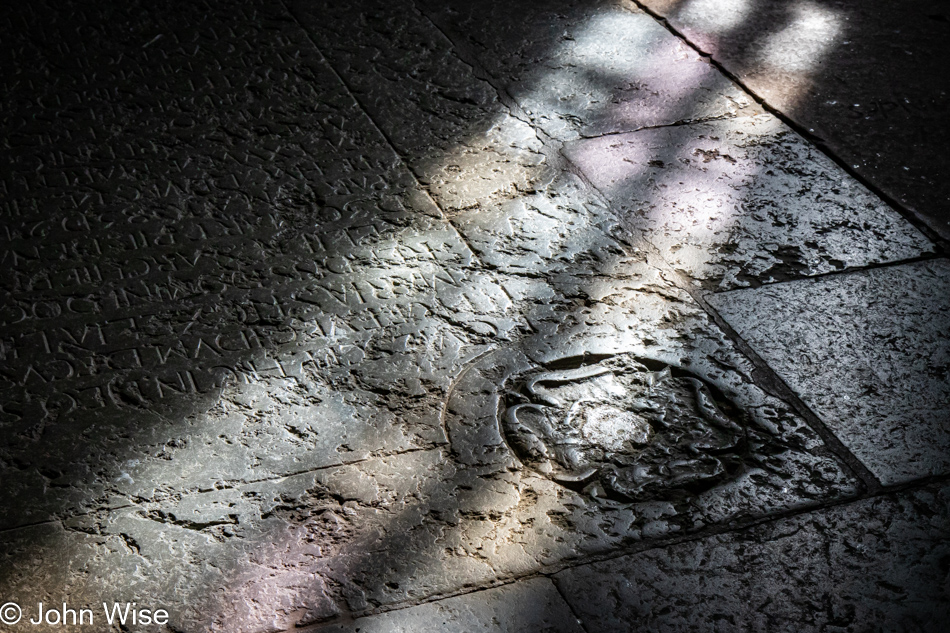
By the way, this visit to the Gamla Uppsala Church marks the 20th house of the Lord we’ve visited on this trip, although with a few of them, we could only peek in or had to content ourselves with views from the outside as the doors were locked. I count them all because it’s like graves; we don’t get to look into those either, but we have visited them all the same and most people would accept that as truth.
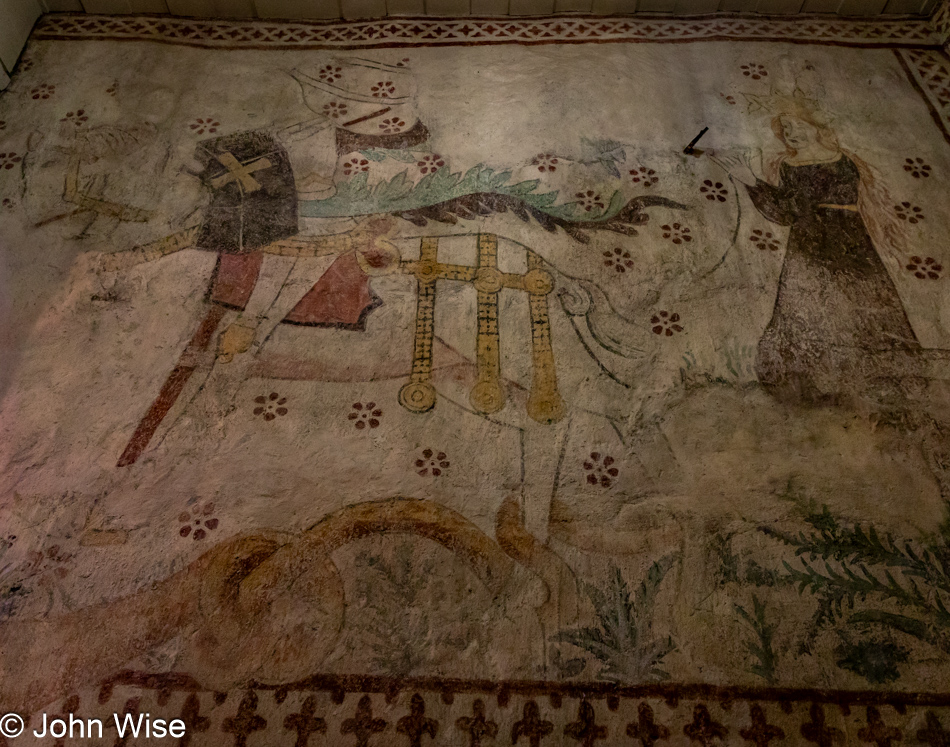
Some things must simply remain a mystery. When whatever secrets or information about certain details cannot be found, there will be nothing to learn, nothing to share, and so it is with this obviously old fresco.

The complex here at Gamla Uppsala, taken as a whole, is incredible and well worth the visit, but the museum is rather light on artifacts. With no other fees to visit the mounds and church, this felt like a worthy donation to the upkeep of this historic corner of Sweden.
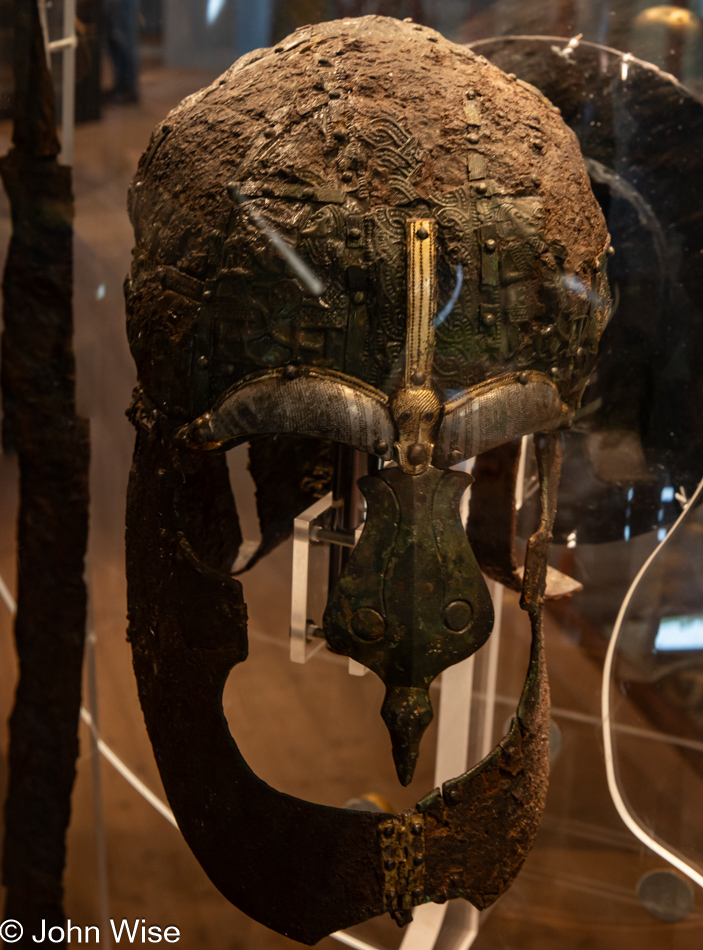
I collect visual souvenirs, never knowing which ones of the thousands will appeal to me after the end of the adventure and so it is with this helmet. If there was a data sheet about the piece regarding where it was found or who it might have belonged to, I missed it. Searching for information, I found a single source online implying it belonged to early King Eystein Adilsson, who lived 75 kilometers (46 miles) west of here, but that source was a genealogy and the author’s attempt to create dreams of distant relations by posting an image of this armor seemed like a stretch. There are no other supporting sources supporting this claim, leaving me to believe this information is fake. It’s a shame that this is our state of the internet, where history is whatever somebody says it is. Now I can try and reflect on how many bunk “facts” I’ve tossed into the maelstrom of the past.
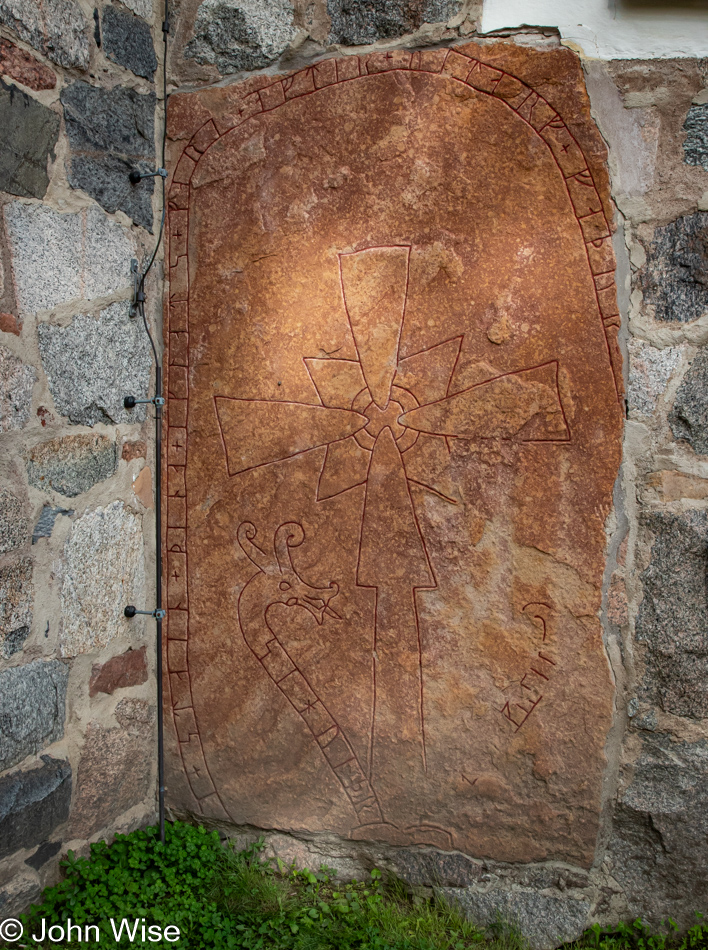
As we were leaving the museum, we asked one of the women about a runestone we had read was here at the church. She told us that it can be found mounted in one of the exterior walls of the Old Church. The rune translates to, “Sigvid the Englishman [erected] this stone in memory of Vidjärv, [his] father…”

Next to the church and museum, there’s a wonderful old wooden house that plays host to Odinsborg Restaurant where we took lunch today. The open-faced sandwich might not be called smørrebrød in Sweden, but that doesn’t mean we won’t enjoy it as such. Sadly, I have to inform Caroline through this sentence right here that she missed the opportunity to try Odinsborg’s home-brewed mead served in Viking horn tankards.
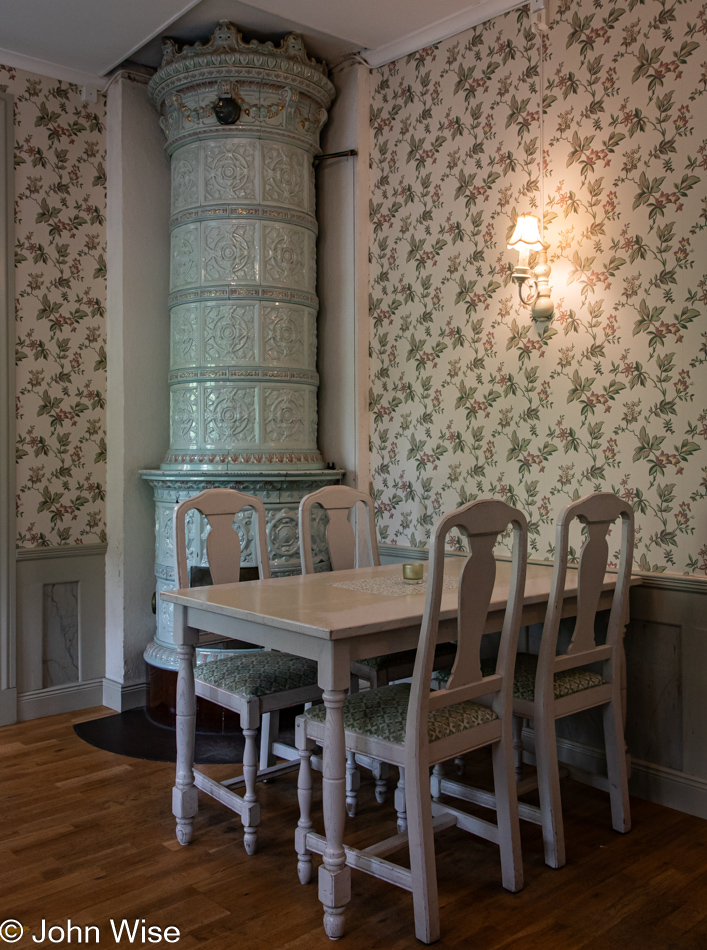
The inside dining area of Odinsborg was mostly empty, with the majority of patrons sitting outside in the sun enjoying the perfect weather. After our shrimp-and-egg lunch, we shared a rhubarb torte with vanilla cream, and not able to exercise any self-control, I ordered a Belgian waffle with berry compote and whipped cream at the same time. That took a few minutes to prepare, so you might guess Caroline’s surprise when dessert number two showed up. Imagine mine when I realized that Belgian waffles are best enjoyed in Belgium.
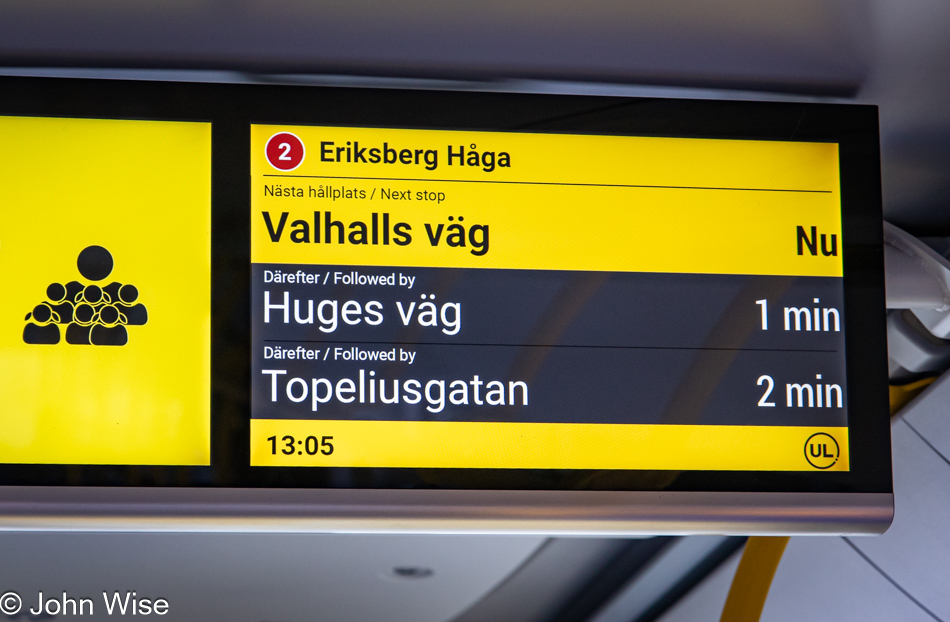
This would be our first time on a Swedish bus, and whenever trying a form of transportation in a different country, there’s a trepidation if we have our duckies in a row, meaning tickets and destination. We’ve scored on this bus that promises to bring us to Valhalls vag and then a huge vag as though I’m old, I’m down with visiting exotic and foreign vag.
[John, could you be any more of an idiot with this childishness? Väg is pronounced “vay” and means road or way, NOT vagina, you infantile puerile old fart, while Huges might be referring to the name Hugo of Germanic origin. So the stop could be “Hugo’s Road” and consequently also be referencing the 12th century Bishop Henry of Uppsala, sometimes referred to as Henrik or Hugo – Caroline]
Oh really, Caroline, I just learned that David Chase, who created the Sopranos TV show, named the character of Salvatore “Big Pussy” Bonpensiero after he traveled this exact bus line and chuckled to himself about the reference to huge vagina! Just kidding. By the way, Topeliusgatan translates to “Taking the piss.”

In my trip planning, I’d seen that the Uppland Museum here in Uppsala was open from 12:00 until 5:00 today (a Sunday), so with time to spare, we dipped in. It is hardly a great museum and might even be considered a bit less than mediocre, but they are closing up shop in the next weeks to make way for new exhibits, so maybe there will be some improvement when next year rolls around. As for what’s in the photo, you should know by now that if there’s yarn in the image, it must have something to do with fiber arts (loom weights and spindle whorls). The coolest things about this museum might be the remnants of an old water mill in the Fyris River and that Ingmar Bergman shot the outside of the building as the bishop’s house in the film Fanny and Alexander.
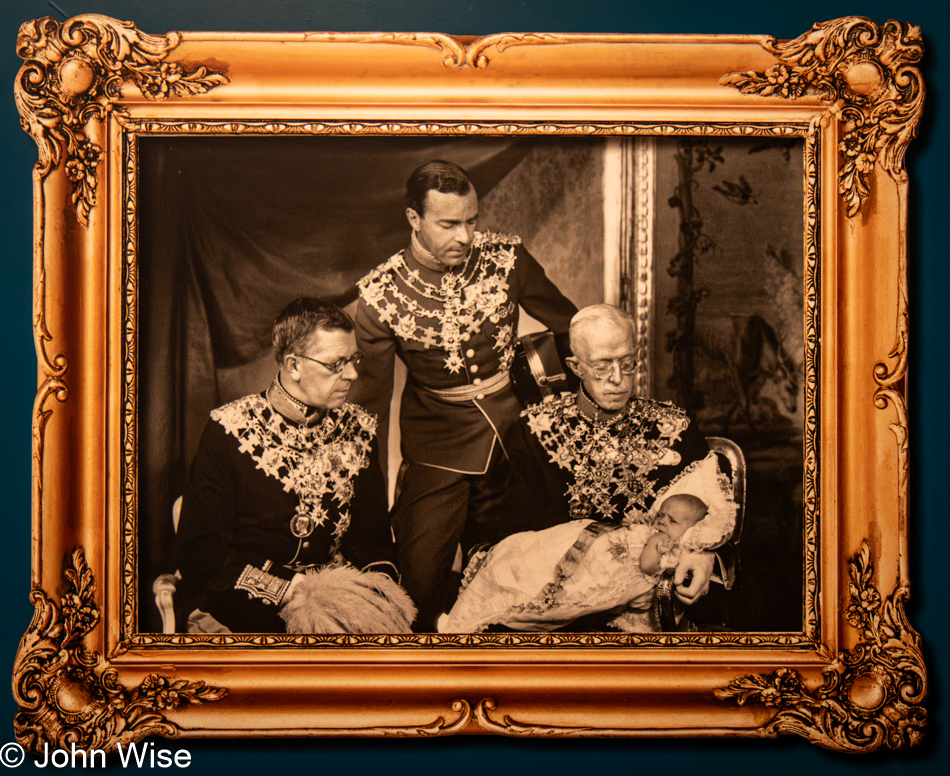
This photo was pretty interesting, too, as we are seeing four generations of the monarchy. Prince Carl Gustaf, who would grow up to be King Carl XVI Gustaf is the baby at his christening on 7 June, 1946. King Gustaf V, his great-grandfather, is holding him. To the far left is Crown Prince Gustaf VI Adolf the King’s grandfather, and in finally behind the grandfathers is Heir Apparent Prince Gustaf Adolf, Carl’s father.

On the way back to Uppsala, we learned that there are other runestones aside from the ones we’ve already seen at the university. Only a couple of them were worth photographing, as a majority of the old Viking signs had wooden frames around them due to some kind of work going on in the area.

Our bus dropped us closer to the university than where we really wanted to go next, but our destination was only a 10-minute walk away, so everything was good. Plus, we’ve seen yet more runestones.

Our fingers are crossed that reasonable weather remains on our side as we enter the Linnaeus Gardens, and former summer home of the Carl Linnaeus family. Carl Linnaeus is the man who, a few hundred years ago, turned humanity on to taxonomies. The gardens and buildings here are effectively a museum to the efforts of this Swedish botanist, zoologist, taxonomist, and physician, of whom August Strindberg once said, “Linnaeus was, in reality, a poet who happened to become a naturalist,” while Goethe wrote: “With the exception of Shakespeare and Spinoza, I know no one among the no longer living who has influenced me more strongly.”
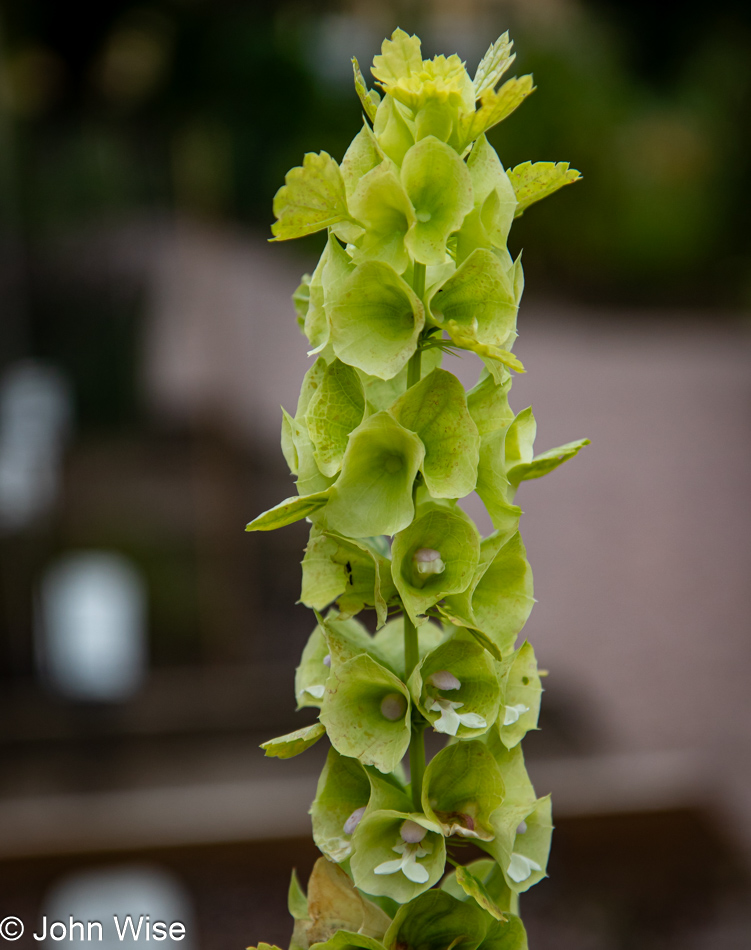
From botany to zoology, Linnaeus created the modern system of naming species. Take this: Moluccella laevis L., also known as Bells of Ireland. Moluccella is this plant’s genus, while laevis is the species, and finally, the trailing L is the initial of the person who named it, in this instance, that is Linnaeus himself. There is more to the taxonomic description involving family, order, clade, phylum, and kingdom, but the first two parts of the name will get you what you are looking for, while these additional descriptors arrived after Linnaeus offered us the structural foundation of taxonomy.
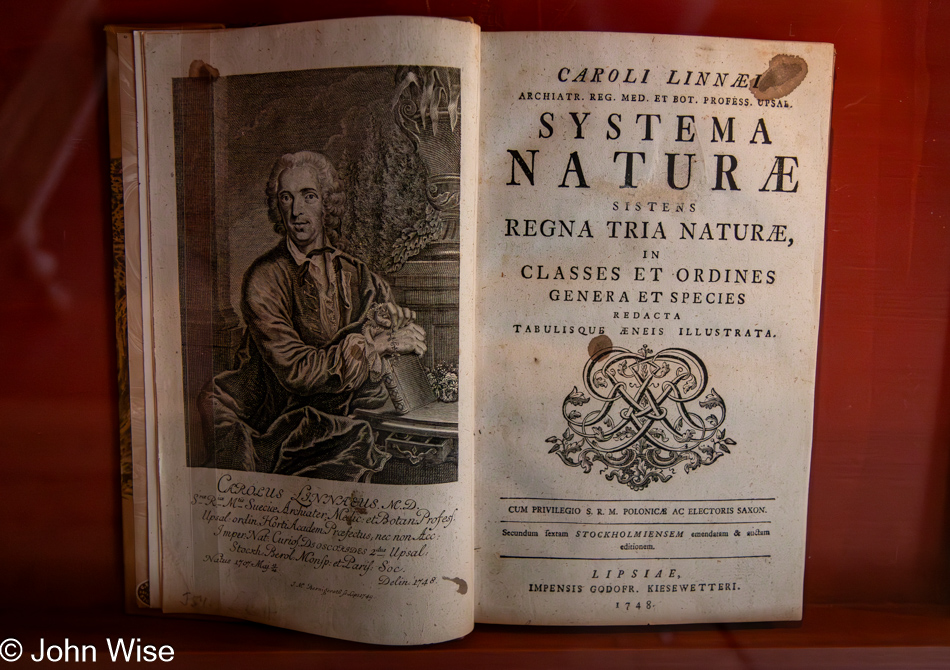
There were many plants in the garden that Linnaeus himself would have cultivated, along with small monkey shelters atop raised platforms as he also studied primates, but the overcast sky wasn’t conducive to capturing stunning images of the plants, so we turned our attention to the museum.
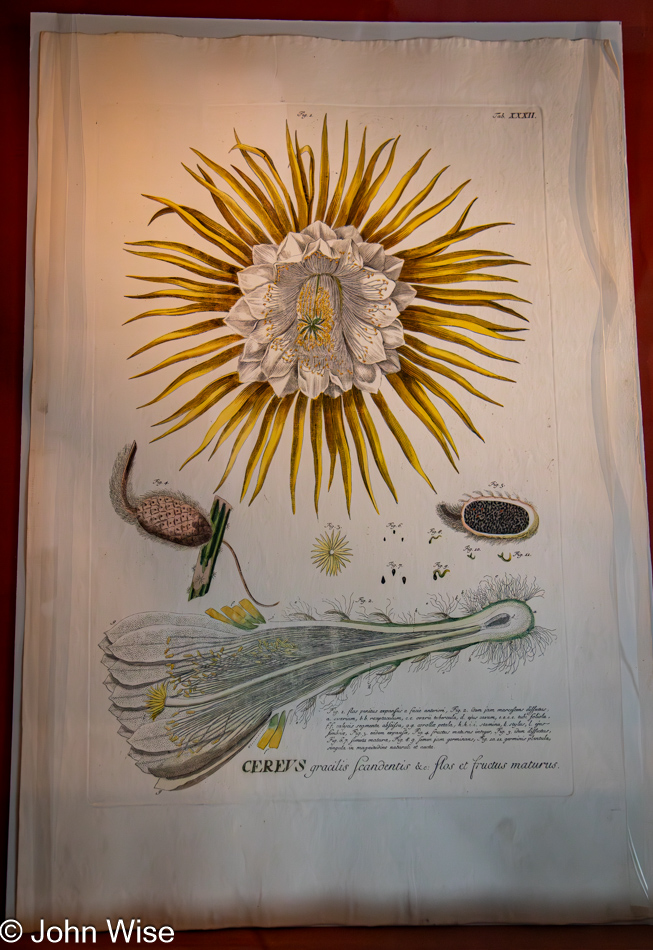
When this book titled Systema Naturae was first published in 1735, it was only 12 pages long, but by the 10th edition, it had grown to include 4,400 species of animals and 7,700 species of plants. Within two more editions, things had gotten so extensive that Linnaeus gave us the concept of the index card, which he required to track the growing volume of species he was naming.
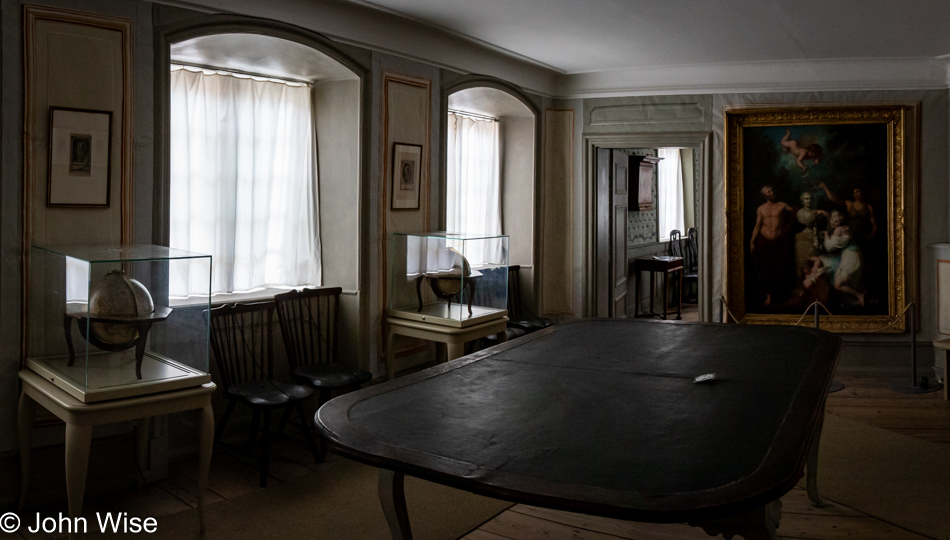
I know that it was at the end of the travel season when we arrived here, and it’s Sunday, but there were very few visitors, which turned out nicely for us because we could linger, looking in on some of the things that this major contributor to science lived with and that inspired him.
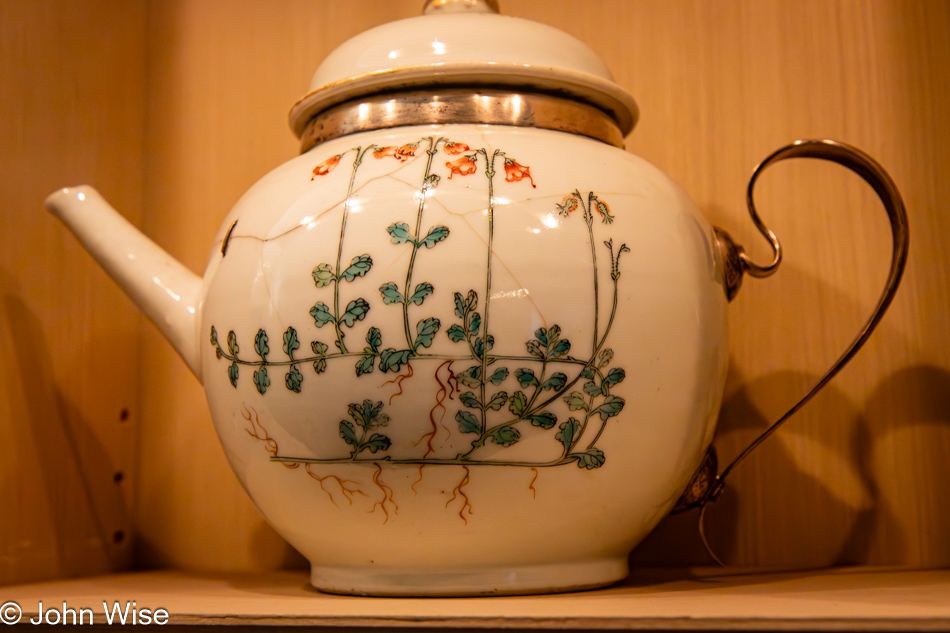
The twinflower was Linnaeus’s favorite flower, and as such, it was named Linnaea borealis L. It is the flower that adorns this teapot that accompanied a tea service gifted to him from the Swedish School — I have no idea what Swedish school this refers to.
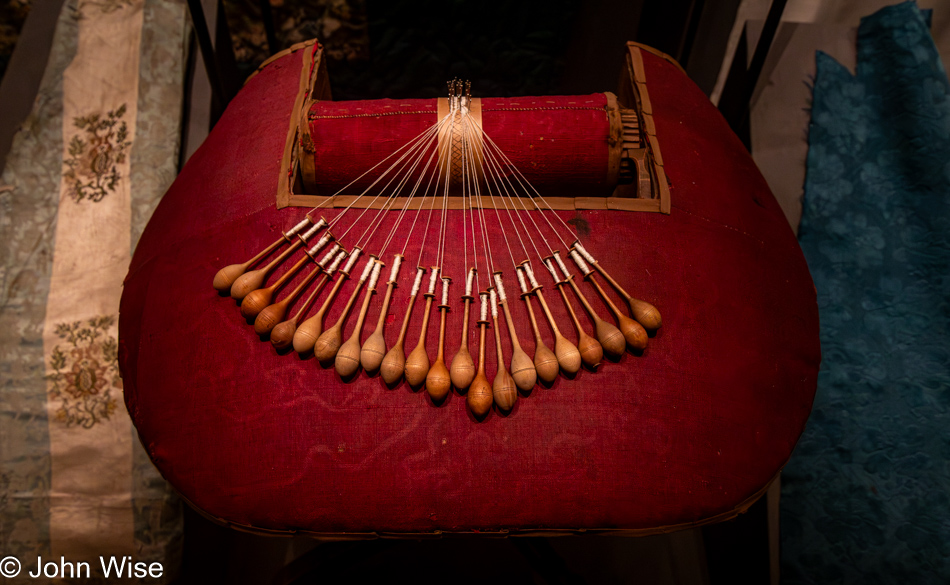
A lace-making table that would have been relatively commonplace among well-to-do households who had a need for fineries.
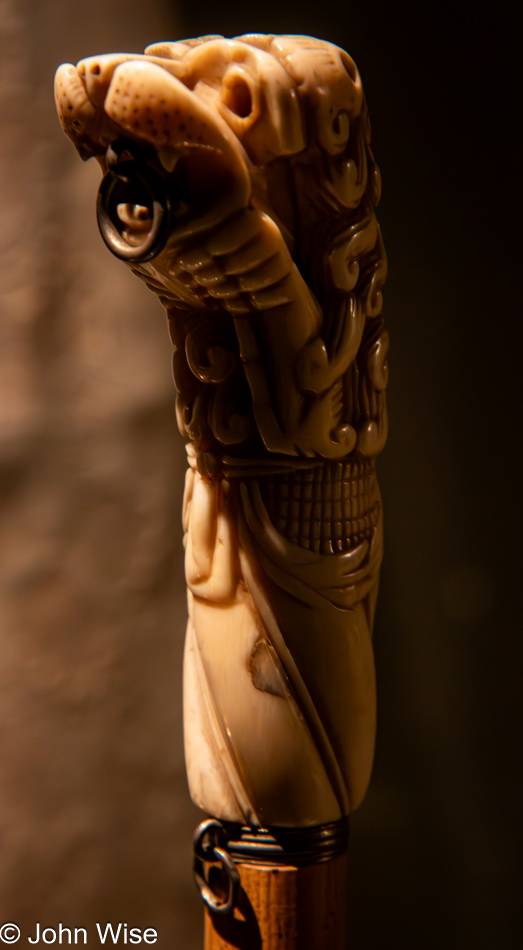
There are quite a few personal items in the museum, including preserved creatures in formaldehyde and the cane used by Linnaeus.
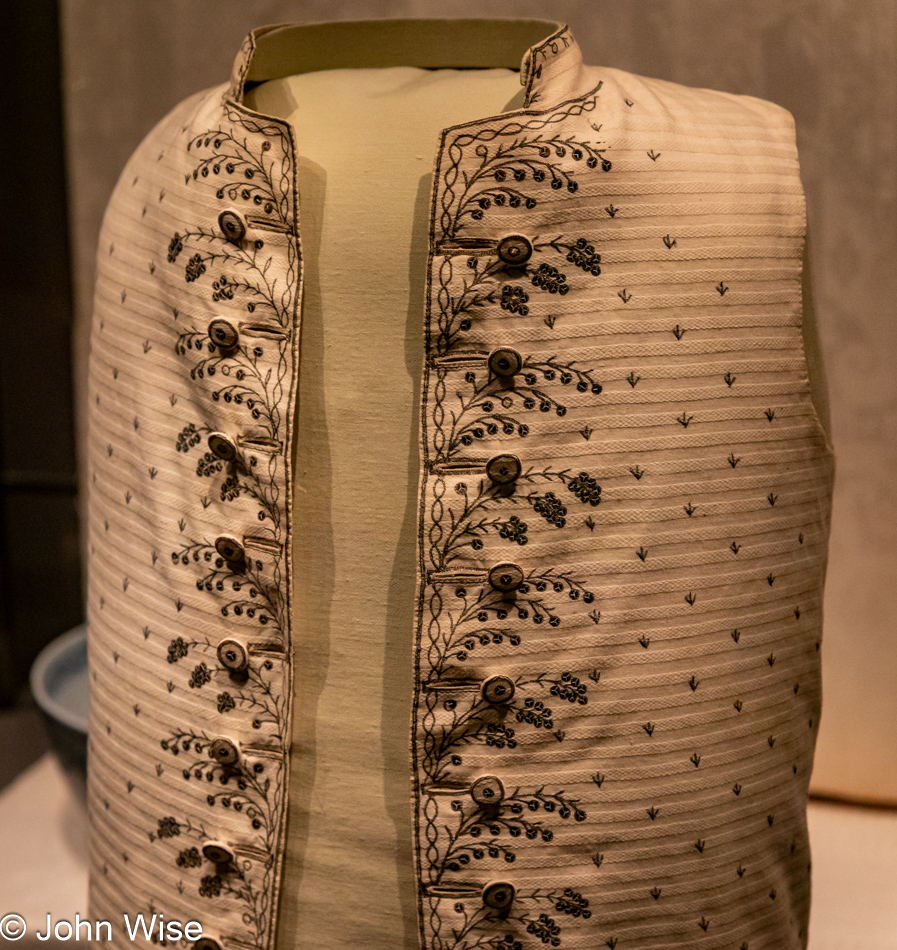
This is supposed to be the actual embroidered waistcoat worn by Linnaeus and not a recreation; it’s in incredibly good shape.
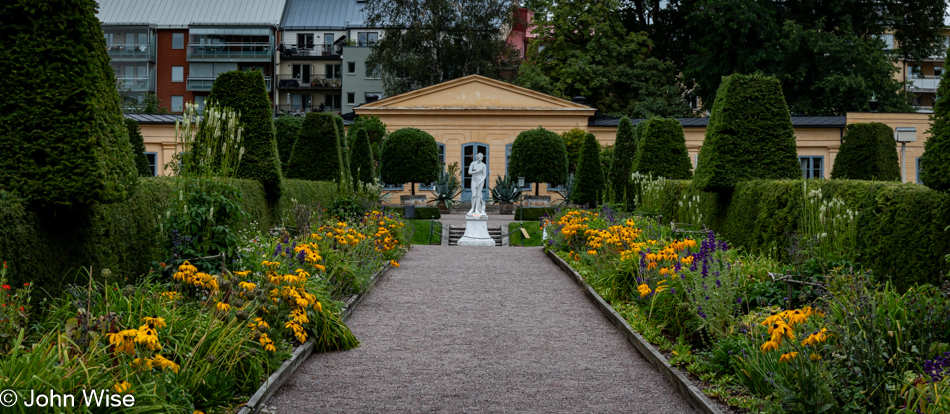
A glance back at the garden, and it was time to leave.
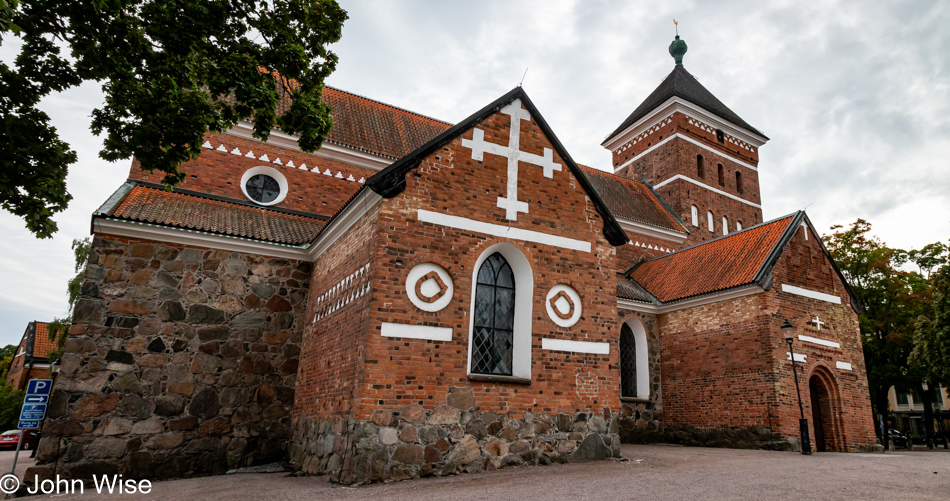
This is the Helga Trefaldighets Kyrka or Holy Trinity Church. This is the third church we were visiting on this day, possibly a record or at least a tie with some previous day.

There’s not much on the internet to share about this church; even the dates of construction and consecration are unknown. The best guess is it was built towards the end of the 13th century and consecrated in the very early 14th century, with the first mention of the church in 1302.
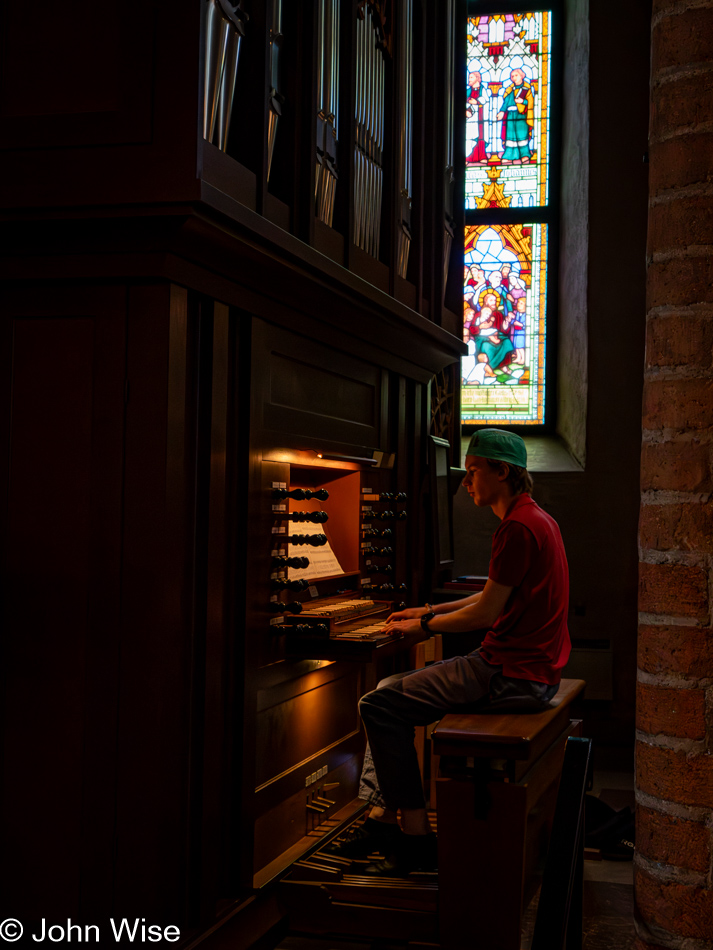
Another stroke of luck, a young student is practicing on the organ, the green cap he’s wearing shows that he’s an apprentice.
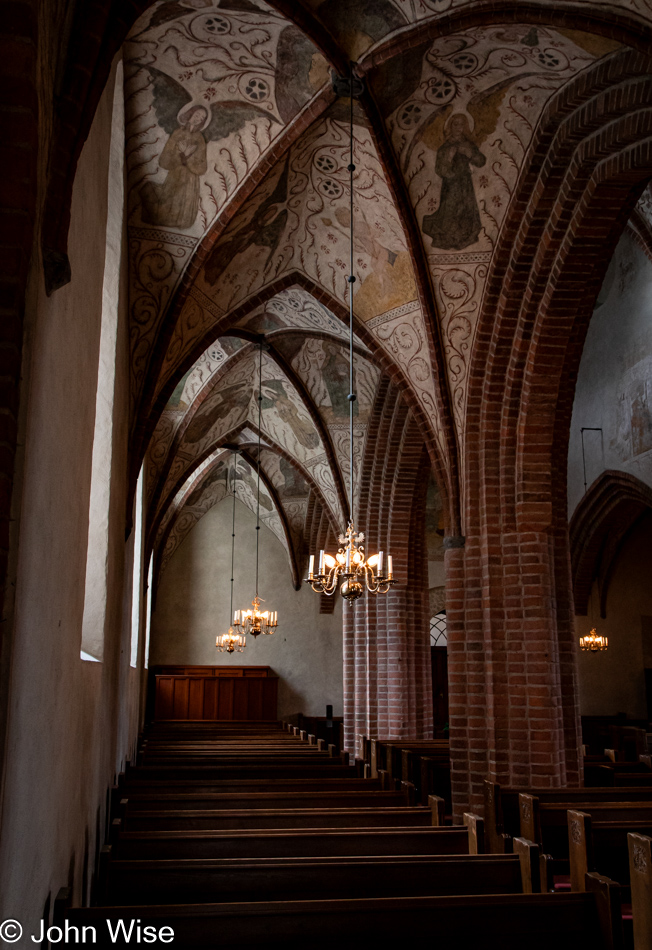
Even in the afternoon overcast light, the effect of natural light spilling into the church is dramatic. How could others not be drawn into such visual spectacles?
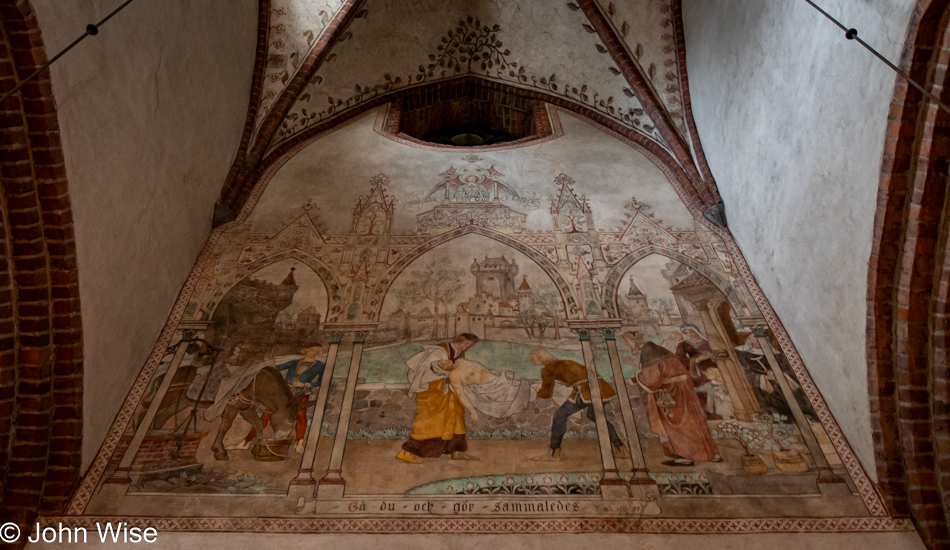
This mural by Albertus Pictor is certainly not a biblical scene as it appears more medieval to me; my half-educated guess is that it depicts the death of King Eric IX.
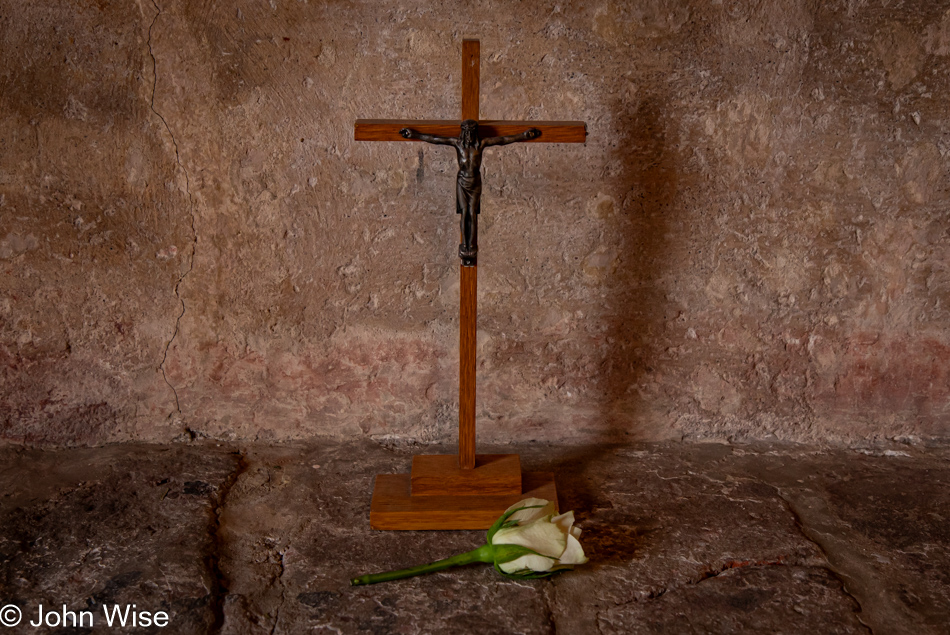
Sometimes, even the most simple scene can lend beauty and thoughtfulness to what would otherwise be plain.

Pull the old handle; it is now time to leave this place, too.

We walked into Peppar Peppar with low expectations as there was only one other table for two dinner guests occupied. True, we were early, having made a reservation for 5:00 on the first day of their reopening after their own summer holidays. And dinner was amazing on all fronts. We started with smoked deer cheesecake, which wasn’t a dessert but an incredibly yummy appetizer. Caroline ordered what was likely the cheapest thing on the menu with the warning that it would run out fast: fried herring, drawn butter, mashed potatoes, and lingonberry because in Sweden if a dish doesn’t arrive with lingonberry, it’s not really Swedish. The herring was so awesome that I asked the server about the preparation, and the kitchen actually shared it; here it is:
Marinate the herring filets in mustard and Crème fraîche for two days. Bread with dark flour, salt, and pepper. Fry in a neutral oil with lemon zest thrown in when adding the fish.
As for me, I ordered the reindeer filet and Västerbotten cheese terrine, chantarelles, cranberries, and game velouté. Afterward, we shared a dessert of Crème caramel with condensed milk, lemon thyme, and lingonberries. This restaurant is a treasure.

Train back to Stockholm, pack, skip the shower, and sleep. Tomorrow in the early morning, we depart for a nearly six-hour train ride to Oslo, Norway. This vacationing thing can be exhausting.